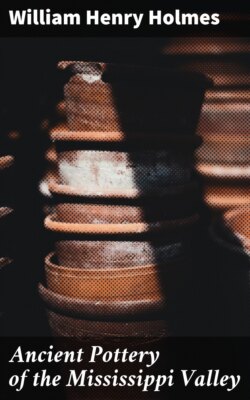Читать книгу Ancient Pottery of the Mississippi Valley - William Henry Holmes - Страница 3
На сайте Литреса книга снята с продажи.
INTRODUCTORY.
ОглавлениеTable of Contents
This paper is the third of a series of preliminary studies of aboriginal ceramic art which are intended to be absorbed into a final work of a comprehensive character.
The groups of relics selected for these studies are in all cases of limited extent, and are such as can lay claim to a considerable degree of completeness. It is true that no series of archæologic objects can ever be considered complete, but in exceptional cases the sources of supply may be so thoroughly explored that the development of new features of importance cannot reasonably be expected. If any series of American ceramic products has reached such a condition, it is that of the middle portions of the Mississippi Valley; yet, even in this case, I consider it unwise to attempt a monographic study, and prefer to single out a particular collection, making it the subject of a thorough investigation.
When the idea of preparing such a paper was first conceived, the collection presenting the greatest advantages was that of the Academy of Natural Sciences at Davenport, Iowa, which was, therefore, chosen. Other museums, especially those at Cambridge, Saint Louis, and Washington, were rich in material from this region, but none of these collections were so homogeneous and satisfactory.
The National Museum has recently received important accessions from the Mississippi Valley, through the agency of the Bureau of Ethnology, and ere the publication of this paper will probably excel all others in the number and variety of its mound relics. Some of its material has already been published by Dr. Charles Rau, Prof. C. C. Jones, Dr. Joseph Jones, and myself, and several additional examples are given in this paper.
Professor F. W. Putnam has described and illustrated many pieces belonging to the Peabody Museum, and Professor W. B. Potter and Dr. Edward Evers have issued an important work on the Saint Louis collections, in Contributions to the Archæology of Missouri.
This study is intended to pave the way to a thorough classification of the multitude of relics, and to the discovery of a method of procedure suited to a broad and exhaustive treatment of the ceramic art.
I do not expect to discuss ethnical questions, although ceramic studies will eventually be of assistance in determining the distribution and migrations of peoples, and in fixing the chronology of very remote events in the history of pottery-making races.
Some of the results of my studies of the evolutionary phase of the subject are embodied in an accompanying paper upon the "Origin and Development of Form and Ornament," and a second paper will soon follow. Before the final work is issued I hope to make close studies of all the principal collections, public and private. In such a work the importance of great numbers of examples cannot be overestimated. Facts can be learned from a few specimens, but relationships and principles can only be derived from the study of multitudes.
I shall probably have occasion to modify many of the views advanced in these preliminary papers, but it is only by pushing out such advance guards that the final goal can be reached.
Since the original issue of this paper in the Proceedings of the Davenport Academy of Sciences, a careful revision of the text has been made and much additional matter and a number of illustrations have been added.
I wish in this place to express my obligations to the officers and members of the Davenport Academy of Sciences, and especially to Mrs. M. L. D. Putnam and Prof. W. H. Pratt, whose generous aid has been of the greatest service to me.
